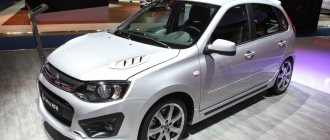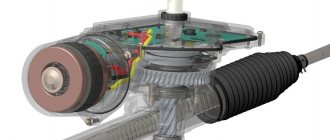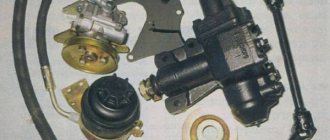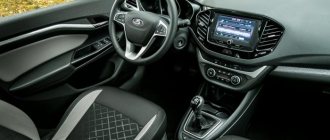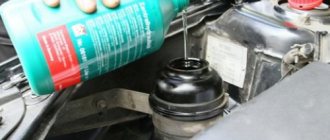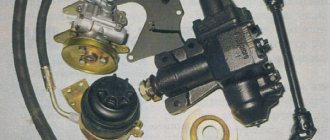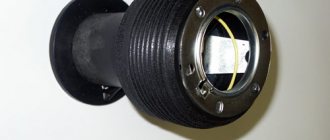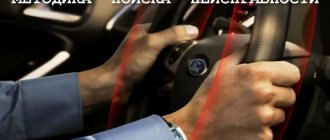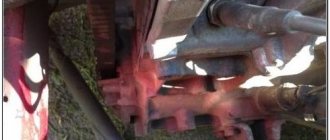You can determine which unit is installed on the selected brand of car without the help of the seller. To do this, you need to look under the hood of the car. If you find a tank there with a corresponding pictogram depicting a steering wheel, it means that in front of you is a car with power steering. It is into this tank that the power steering fluid is poured. If there is no reservoir, and the steering wheel turns freely, then this means that the car has an ESD installed.
Healthy! In some cars, the power steering fluid reservoir is located in the bumper and the device is a hybrid of electric and hydraulic power steering. But such cars can be counted on one hand. For example, several Opel Zafira models are equipped with just such “hidden” power steering units.
To figure out whether electric power steering or hydraulic power steering is better, it’s first worth talking about the features and differences of each of these systems separately.
Power steering
Power steering is more common today, unlike the electrical system, which is just gaining momentum. The hydraulic booster consists of complex components - low and high pressure pipelines, belts and other elements through which fluid circulates, poured into a special tank connected to pumping equipment. As soon as the driver turns the steering wheel, a number of processes occur. First, high-pressure fluid is supplied through the distributor into the steering mechanism, after which it is pumped into the hydraulic cylinder, thereby creating pressure that affects the piston. As a result of the displacement of the latter, the degree of effort that the driver applies to turn the steering wheel is reduced. When moving along a straight path, the power steering fluid flows back into the reservoir. As you can see, this is a rather complex closed fluid circulation system, in which many elements are involved, each of which can fail over time.
If we talk about the features of power steering, it is worth mentioning the following disadvantages:
- The hydraulic booster consumes engine energy, and as a result, engine power drops noticeably.
- The system is quite capricious and requires periodic maintenance (the power steering fluid should be replaced every 50,000-80,000 kilometers or as soon as its level in the reservoir drops to a minimum level). In addition, quite often you have to tighten the pump belt.
- A prerequisite for the proper functioning of the power steering is the complete tightness of the components.
- Temperature fluctuations have a detrimental effect on the power steering fluid, resulting in a decrease in the efficiency of the entire system as a whole.
In addition to these shortcomings, many car enthusiasts often complain that the power steering hums when turning. This problem may be due to a breakdown in the steering rack, problems with the pump, belt or poor quality oil. As a result of the fact that the system, designed to simplify the life of motorists, began to bring a lot of trouble, a simpler and more convenient mechanism was developed - an electric booster.
Electric power steering
The design of the electric power steering is much simpler than that of a hydraulic booster. By and large, this is a small electric motor, a control unit and two sensors: torque and angle of rotation. A device mounted on the steering rack or column itself reads information about which driver is transmitting the steering angle. In this case, torque is transmitted using a torsion shaft, which is built into the steering unit.
If we talk about how power steering differs from electric power steering, then in the first case, the force applied to the steering wheel is reduced due to pressure and circulating fluid, in the second, the information is converted thanks to electrics, as a result of which the wheels turn slightly. In this case, the electronic power steering unit analyzes the data and, based on it, calculates how much current the electric motor will require. Thanks to this, when parking or sharp maneuvers, the greatest effort is produced from the EUR. During slow turns, the electric power steering reduces torque and is practically not used.
We recommend: Which used car is better to buy: the most reliable used cars
If we talk about the advantages of electric power steering over power steering, then it is worth noting the following advantages of the electric amplifier:
- It takes up minimal space.
- During operation, the EUR consumes energy only at those moments when it is in use. The power steering works constantly as soon as you start the engine.
- The electric booster operates uninterruptedly both in severe frosts and in hot weather.
- Since the EUR consists of fewer elements, it is more reliable, since it does not require constant maintenance and repair.
However, electric boosters have their own characteristics that confuse some drivers. Therefore, let’s try to figure out which system performs better in management.
Operating principle of power steering (power steering)
Power steering (power steering) involves the use of liquid (oil) as an object that creates pressure on the walls of the piston. When the engine starts, the pump turns on. By means of a belt drive, the torque from the engine is transmitted to the impeller of the pump, which begins to pump oil from the tank (oil reservoir) and drives it through the system (closed system: tank, pump, distributor, hydraulic cylinder, tank), creating excess pressure in it. At the moment when the driver turns the steering wheel, the distributor directs working fluid under pressure into one or another chamber of the hydraulic cylinder, its piston moves and pushes the steering rods - steering becomes easier and the wheels turn. The distributor re-engages when the driver turns the steering wheel in the opposite direction. Thanks to this device, fluid is supplied to another chamber of the hydraulic cylinder and the piston supplements the force created on the steering rods.
The hydraulic steering mechanism is connected through a gear transmission to the steering rack and transforms the torque into translational motion; in the event of a failure of the hydraulic booster (power steering), it independently, without the help of a hydraulic cylinder, transmits it to the steering rods. The driver will definitely feel the moment when the required force on the steering wheel has changed; the main thing is to react in time. Therefore, one of the features of power steering (power steering) is constant monitoring and timely maintenance of the mechanism and its components.
Advantages:
- high power potential (an enviable indicator for trucks and SUVs);
- relatively low cost production and maintenance.
Flaws:
- constant operation of the pump (when the car moves in a straight line, the pump works to transfer oil in a closed circle, since excess pressure can be required at any time);
- takes away engine power, even if it is intended to move in a straight line;
- subject to operational interruptions due to temperature changes;
- probability of failure when working in critical positions;
- has not proven itself at high speeds;
- The fluid has to be changed from time to time.
Possible malfunctions:
- pump wear (repair and replacement of parts are allowed);
- faulty power steering gearbox;
- distributor malfunction (valve malfunction and spool wear may occur);
- wear of shafts and bearings;
- the system is not tight (hoses, seals) or the liquid level is low, the system is airy.
Operating principle of power steering and power steering
Hydraulic power steering column rotation appeared in the last century and was initially installed on trucks. In the 80s, it migrated to passenger cars, where it serves faithfully to this day. At the moment, approximately 60% of new machines are equipped with hydraulics . Electric amplifiers were introduced later and began to be widely used after 2000, gradually conquering the automotive market.
To see the difference between one power steering and another, you need to consider the operating principle of both mechanisms. Power steering is a rather complex unit, consisting of several separate elements:
- a pump connected by a belt drive to the engine crankshaft;
- expansion tank for hydraulic fluid;
- a piston installed in the steering rack;
- a hydraulic distributor that sets the direction of movement of the piston.
The listed elements are connected by metal tubes with circulating liquid. Its task is to transfer the pressure created by the pump at the right moment to the piston, which pushes the rack shaft and thus helps turn the wheels of the car. In general, power steering works like this:
- After the engine starts, a pump rotated by the crankshaft builds up pressure in the system. While you do not touch the steering wheel, excess pressure is released into the expansion tank.
- When you try to turn the steering wheel, the distributor mounted on its shaft opens the desired line and directs the fluid into one of the chambers located on the right or left side of the piston.
- Under pressure, the piston moves and pushes the steering rack shaft simultaneously with the rod attached to the front wheel steering knuckle.
- If the steering wheel is turned in the other direction, the distributor will close the first line and open the second, pressure will arise in the other chamber and the piston will move in the opposite direction.
The sharper and stronger you turn the steering wheel, the more pressure is transferred to one of the chambers and the force applied to turning the wheels increases. The system only reacts to the rotation of the main shaft, and when driving in a straight line or parked with the engine running, it continues to work, but does not affect the rack.
The difference between electric power steering and power steering is that the rack shaft is moved by an electric motor controlled by a separate electronic unit (ECU). The operating algorithm is as follows:
- After starting the engine, voltage is supplied to the control unit, but the EUR remains inactive.
- The slightest turn of the steering wheel is detected by a special sensor that transmits an impulse to the ECU.
- Based on the sensor signal, the controller commands the electric motor to rotate the steering shaft in one direction or another through a gear transmission.
The rotation speed of the electric motor shaft and the amplification power are determined using a second torsion sensor, which twists when the steering wheel is turned sharply.
Pros and cons of different amplifiers
The use of hydraulics to make driving easier is due to the following advantages of power steering:
- lower production costs, affecting the final price of the new machine;
- You can get more power from the hydraulic booster, allowing it to be used in trucks and minibuses of any carrying capacity;
- reliable design, proven over years of operation.
The main disadvantage of the hydraulic system is the need to control the fluid level and periodic maintenance . It is necessary to ensure that the seals of the piston mechanism, distributor and pump do not leak, change and tighten the belt in time, and lubricate the bearings.
Other disadvantages are not so significant:
- The booster pump runs continuously as long as the engine is running. This increases fuel consumption.
- To prevent the oil pressure in the lines from exceeding a critical level, you cannot hold the steering wheel turned to its extreme position for more than 5 seconds.
- On budget car models, the power steering-assisted steering wheel becomes “empty” at high speed.
As opposed to hydraulics, the electric power steering has the following advantages:
- the electric motor and control unit with sensor do not require inspection or maintenance;
- the dimensions of the unit are much smaller, which is why in small cars it fits behind the dashboard;
- the system does not consume electricity unnecessarily, which means it does not consume excess fuel;
- The steering wheel can be held in any position for as long as desired.
We recommend: The best cars from China on the Russian market in 2019
Another feature of the electric power steering is the ability to change operating settings depending on driving conditions and artificially create “heaviness” in the steering wheel at high speed. In addition, the EUR is capable of “steering” the car independently when driving in a straight line, which is implemented on many premium cars.
The weakness of the electric amplifier is its high price . And the higher the cost of the unit, the more expensive its repair will be, and often a failed EUR has to be replaced entirely.
The second drawback is the low drive power, so such amplifiers are not installed on heavy vehicles and minibuses.
Electric power steering
Electric power steering circuit
In electric power steering (EPS), additional force when turning the steering wheel is created by an electric motor.
Design and principle of operation of electric power steering
The main elements of the electric amplifier include:
- electric motor;
- torsion bar and steering column shaft;
- steering mechanism (gearbox);
- steering wheel position sensor;
- torque sensor;
- electronic control unit.
When the driver turns the steering wheel, the torsion bar begins to twist. The torque sensor measures this twisting, determines the torque value from it and transmits this information to the control unit. The latter processes data from the power steering sensors and correlates them with the readings of other vehicle sensors (speed, crankshaft revolutions, etc.).
The control unit calculates the force that must be applied to help the driver turn the steering wheel and gives the appropriate command to the electric motor. The latter acts on the steering column shaft or steering rack, thereby facilitating rotation of the steering wheel.
Advantages and disadvantages of EUR
Electric power steering rack
The main advantages of an electric amplifier include:
- fuel efficiency - the EUR does not take power from the engine and turns on only when the steering wheel is turned;
- reliability associated with the absence of a hydraulic system;
- compactness and ease of maintenance;
- ability to adjust steering characteristics and settings;
- the possibility of implementing automatic vehicle control.
Despite numerous advantages, EUR also has some disadvantages. These include:
- low power while maintaining minimal overall dimensions and cost;
- possibility of overheating and temporary failure under unfavorable driving conditions;
- expensive repairs.
What is an electric power steering wheel (EPS) and how does it work?
Many years after the appearance and successful use of power steering, the EPS appeared - Electric Power Steering. The task of the EUR is the same as that of the power steering - to facilitate steering and steering. Unlike a hydraulic booster, the EUR does not use liquid in its design; instead, an electric motor is used, which creates the necessary force. Among other differences, the EUR is distinguished by a large number of electronics, various sensors, as well as an entire electronic control unit (ECU). The installation principle of the EUR also differs from its hydraulic counterpart. The electric analogue is located directly on the steering rack or steering column itself, and rotation and transmission of torque occurs using a torsion shaft, which is built into the steering system. The hydraulic booster creates force using a pump and fluid, which creates pressure under which the steering mechanisms are shifted and the wheels are turned directly; the electric booster performs the same action, only it uses an electric motor and current for this. When the steering wheel with ESD turns, the ESD torque sensor detects this and reports this to the ECU. Then the electronic unit analyzes the data and, guided by certain algorithms, determines the amount of current required for the electric motor to turn the steering wheel. A characteristic difference for the electric power steering is the ability to increase/decrease the force depending on the speed of the vehicle. As you know, at speed, turning the steering wheel is much easier and there is practically no need for a booster, but a hydraulic booster, unlike an electric booster, is not able to take into account the speed of movement and the angle of rotation, due to which at speed the steering wheel of a car with power steering becomes “wobbly” and uninformative. The ESD takes into account the speed of the car and reduces the gain, as a result the steering becomes sharper, and the driver has better control of his car during maneuvers.
Design and principle of operation of power steering
Hydraulic power steering is one of the earliest forms of technology. This system consists of various components and parts such as the pump, pulley, drive belt, hoses, and power steering fluid. They all work together to create the hydraulic force that turns the steering wheel so easily. But let's look at how this pressure is created.
Your car's engine contains a vane pump that creates hydraulic pressure at the right time. Whenever you turn the steering wheel, the pump will generate more hydraulic pressure to increase the force when you turn the steering wheel. The pressure increases because additional hydraulic fluid enters the hydraulic cylinder from the valves. Once this happens, the mechanism receives pressure from the cylinder and causes the wheels to move along with the steering mechanism.
Electric power steering
Electric power steering circuit
In electric power steering (EPS), additional force when turning the steering wheel is created by an electric motor.
Design and principle of operation of electric power steering
The main elements of the electric amplifier include:
- electric motor
- torsion bar and steering column shaft
- steering mechanism (gearbox)
- steering wheel position sensor
- torque sensor
- electronic control unit
When the driver turns the steering wheel, the torsion bar begins to twist. The torque sensor measures this twisting, determines the torque value from it and transmits this information to the control unit. The latter processes data from the power steering sensors and correlates them with the readings of other vehicle sensors (speed, crankshaft revolutions, etc.).
The control unit calculates the force that must be applied to help the driver turn the steering wheel and gives the appropriate command to the electric motor. The latter acts on the steering column shaft or steering rack, thereby facilitating rotation of the steering wheel.
We recommend: Rolls-Royce Phantom – a legend that is almost 100 years old
Advantages and disadvantages of EUR
Electric power steering rack
The main advantages of an electric amplifier include:
- fuel efficiency - the EUR does not take power away from the engine and turns on only when the steering wheel is turned
- reliability due to the absence of a hydraulic system
- compactness and ease of maintenance
- ability to adjust steering characteristics and settings
- possibility of implementing automatic vehicle control
Despite numerous advantages, EUR also has some disadvantages. These include:
- low power while maintaining minimal overall dimensions and cost
- possibility of overheating and temporary failure under unfavorable driving conditions
- expensive repairs
However, it should be noted that in the design of modern cars, the electric power steering is gradually taking first place, displacing the power steering.
Today, electric power steering is actively replacing hydraulics, as they have much better characteristics and relieve drivers from such manipulations as replacing power steering fluid. In addition, they perform better on the road and have excellent performance. Therefore, if you are purchasing a new foreign car, then preference should be given to electronics; in the case of a VAZ, you should really evaluate the capabilities of the car; perhaps it is better to use hydraulics.
Responsive and feedback steering
Again, we combine the two criteria into a bunch, since there is no particular point in considering them separately. Moreover, in this regard, the power steering is clearly better than the electric power steering. The hydraulic power steering is more responsive, informative and intuitive. Driving a car with electric power steering often takes some getting used to. Some cannot do this, abandoning this technology, if not forever, then for a long time.
The sensations of driving a car are often also brought into this. Most people say that they are more pleasant with power steering than with electric steering. Is this so, it is impossible to prove in words. Need to try. In addition, the so-called “wooliness” of the electric power steering is not felt on all cars. And on the most modern ones, the system is also adjustable, which allows you to adjust sensitivity, responsiveness and feedback to personal preferences.
The bottom line is that electric power steering not yet on all cars pleases its owners according to this criterion. Hydraulics are difficult, if not impossible, to beat in this regard.
What is the difference between power steering and electric power steering?
Let's move on to the comparative characteristics of the electric power steering and power steering in order to ultimately find out which of them is better.
For comparison, let's take the following parameters: device design, ease of use, reliability and efficiency, scope of application.
Device design
Option for placing the EUR in the car
Power steering is a fairly simple mechanism that does not depend on electronic control and is not subject to software failures. On the other hand, the power steering system consists of many connections and seals that are subject to wear during operation. As a result, the node is considered less reliable and requires regular diagnostics.
The EUR, unlike the power steering, is usually located directly on the steering shaft and takes up less space in the engine compartment. Structurally, the electric amplifier is much simpler than power steering, and does not require the use of additional consumables.


